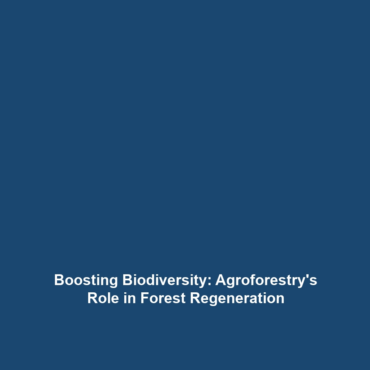The Role of Agroforestry and Sustainable Agriculture Practices in Promoting Forest Regeneration and Biodiversity
Introduction
The increasing rates of deforestation and biodiversity loss are critical environmental challenges facing our planet today. Agroforestry and sustainable agriculture practices present viable mechanisms for addressing these issues. By integrating trees into agricultural landscapes, these methods can enhance forest regeneration and support the conservation of diverse ecosystems. This article explores the significance of agroforestry and sustainable agricultural practices, emphasizing their potential to combat deforestation and promote biodiversity recovery.
Key Concepts
Agroforestry
Agroforestry is the practice of integrating trees and shrubs into agricultural systems. This approach creates a more resilient farming environment, contributing to soil health, carbon sequestration, and improved water retention. Additionally, agroforestry supports wildlife habitats and enhances species diversity, providing a solution to the biodiversity crisis.
Sustainable Agriculture
Sustainable agriculture refers to farming practices that prioritize ecological balance, resource conservation, and social equity. By implementing techniques such as crop rotation, organic farming, and cover cropping, sustainable agriculture reduces reliance on chemical inputs and promotes a healthier ecosystem.
Interconnection with Deforestation & Biodiversity Loss
The role of agroforestry and sustainable agriculture in mitigating deforestation and biodiversity loss is profound. These practices can reverse environmental degradation while ensuring food security and livelihoods for local communities.
Applications and Real-World Uses
Agroforestry and sustainable agriculture practices are operational in various real-world scenarios. Here are a few examples:
- Integrated Cattle and Tree Farming: Farmers practice silvopasture, which incorporates trees, fodder, and livestock, enhancing land productivity while improving biodiversity and soil quality.
- Agroecological Farming Systems: These systems employ agroecological principles to create sustainable farms that mimic natural ecosystems, facilitating forest regeneration and preserving local flora and fauna.
- Reforestation through Agroforestry: By omitting harmful land-clearing practices, agroforestry allows for natural reforestation, significantly impacting forest cover recovery.
Current Challenges
Despite the promising benefits of agroforestry and sustainable agriculture, several challenges remain:
- Economic barriers limit the adoption of sustainable practices among smallholder farmers.
- Cultural perceptions can hinder the acceptance of integrating trees into agricultural landscapes.
- Lack of knowledge and training regarding sustainable methods inhibits potential implementations.
- Political and regulatory frameworks may favor conventional agriculture over innovative sustainable methods.
Future Research and Innovations
Future research is vital to overcoming existing challenges and enhancing the roles of agroforestry and sustainable agriculture practices. Innovations such as:
- Development of drought-resistant tree species suitable for agroforestry systems.
- Advanced soil monitoring technologies to optimize agroforestry benefits.
- Carbon trading schemes to provide economic incentives for farmers implementing sustainable practices.
These breakthroughs aim to promote forest regeneration and combat biodiversity loss, offering hope for a sustainable agricultural future.
Conclusion
Agroforestry and sustainable agricultural practices play a crucial role in promoting forest regeneration and conserving biodiversity amidst the ongoing challenges of deforestation and biodiversity loss. Transitioning to these practices is essential for ecological sustainability, food security, and the restoration of natural ecosystems. To learn more about the positive impacts of sustainable agriculture, explore our articles on sustainable agriculture and conservation efforts.
